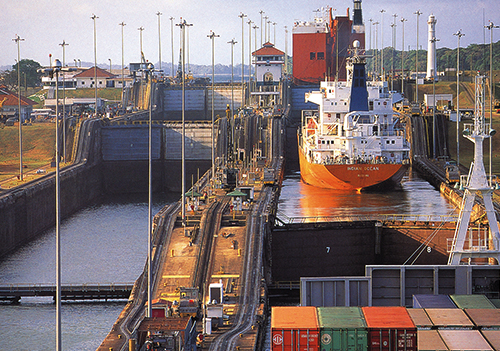
2016 looks set to be a banner year for both shipping magnates and engineering geeks, as the world-famous Panama Canal rolls out its ten-year Canal Expansion project.
Scheduled for inauguration in May 2016, the new-and-improved Panama Canal will boast two new locks and a third lane of traffic, both of which will facilitate the transit of larger cargo ships with impressively increased capacity. The existing "Panamax" limits (the dimensions which permit a ship to pass through the Panama Canal) get upgraded to "New Panamax" standards: an impressive 1201 feet in length, 161 in beam, or width and a cargo capacity of up to 12,000 TEU (twenty-foot equivalent units). This doubles the cargo which can be carried by one ship through the Western hemisphere's only trans-isthmus waterway.
The Canal expansion is causing a ripple effect in key North American shipping ports, many of which are hurriedly adapting their facilities in anticipation of the New Panamax ships. In New York and New Jersey, authorities are spending $1 billion to raise the clearance of the Bayonne Bridge; in Miami, the closest North American port to the Canal, project "Deep Dredge" has increased the depth of the port to 50 feet to accommodate New Panamax Ships.
Designed in response to growing international trade and demand, the Panama Canal Expansion project will facilitate more efficient passageway through the Canal and eliminate delays which today may be up to seven days in the high season. To achieve this, the project includes five primary objectives:
1. To deepen the entrances of the Pacific and Atlantic Canal.
2. To widen and deepen the Gatun Lake navigational channel and the Culebra Cut.
3. To build new locks and water-reutilization basins on the Atlantic and Pacific.
4. Raise the Gatun Lake maximum operational level.
5. To introduce a new 6.1-kilometer Pacific Access Chanel.
At an estimated cost of $5.25 billion, the Canal Expansion is a major undertaking for the tiny Latin American nation, but one its leaders and people agree is essential: almost 80% of Panama's GDP comes from services related to the Canal. Rather than risk having international shipping seek alternatives, Panamanians are banking on the hopes that increased Canal capacity will help them lock down (pun intended) continued preeminence in the regional shipping world for the foreseeable future.
Alexander + Roberts offer numerous ways to experience the unique Panama Canal. Speak to one of our experienced reservation agents about itineraries to the trans-isthmus waterway, such as our full transit
The Complete Panama Canal.